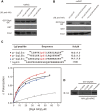Phosphorylation-dependent interaction between tumor suppressors Dlg and Lgl
- PMID: 24513855
- PMCID: PMC3975498
- DOI: 10.1038/cr.2014.16
Phosphorylation-dependent interaction between tumor suppressors Dlg and Lgl
Abstract
The tumor suppressors Discs Large (Dlg), Lethal giant larvae (Lgl) and Scribble are essential for the establishment and maintenance of epithelial cell polarity in metazoan. Dlg, Lgl and Scribble are known to interact strongly with each other genetically and form the evolutionarily conserved Scribble complex. Despite more than a decade of extensive research, it has not been demonstrated whether Dlg, Lgl and Scribble physically interact with each other. Here, we show that Dlg directly interacts with Lgl in a phosphorylation-dependent manner. Phosphorylation of any one of the three conserved Ser residues situated in the central linker region of Lgl is sufficient for its binding to the Dlg guanylate kinase (GK) domain. The crystal structures of the Dlg4 GK domain in complex with two phosphor-Lgl2 peptides reveal the molecular mechanism underlying the specific and phosphorylation-dependent Dlg/Lgl complex formation. In addition to providing a mechanistic basis underlying the regulated formation of the Scribble complex, the structure of the Dlg/Lgl complex may also serve as a starting point for designing specific Dlg inhibitors for targeting the Scribble complex formation.
Figures






References
-
- St Johnston D, Ahringer J. Cell polarity in eggs and epithelia: parallels and diversity. Cell. 2010;141:757–774. - PubMed
-
- Bilder D. Epithelial polarity and proliferation control: links from the Drosophila neoplastic tumor suppressors. Genes Dev. 2004;18:1909–1925. - PubMed
-
- Humbert PO, Grzeschik NA, Brumby AM, Galea R, Elsum I, Richardson HE. Control of tumourigenesis by the Scribble/Dlg/Lgl polarity module. Oncogene. 2008;27:6888–6907. - PubMed
-
- Humbert PO, Dow LE, Russell SM. The Scribble and Par complexes in polarity and migration: friends or foes. Trends Cell Biol. 2006;16:622–630. - PubMed
Publication types
MeSH terms
Substances
Grants and funding
LinkOut - more resources
Full Text Sources
Other Literature Sources
Molecular Biology Databases

